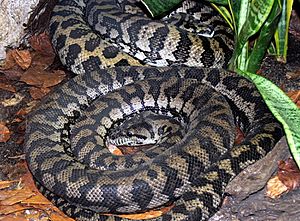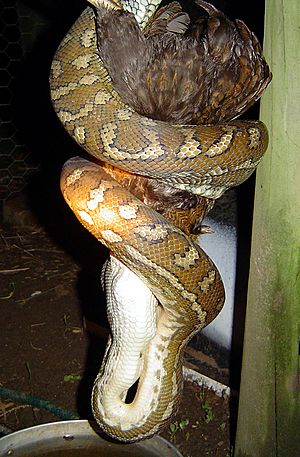Torresian carpet python facts for kids
Quick facts for kids Carpet python |
|
|---|---|
 |
|
| Conservation status | |
| Scientific classification | |
| Genus: |
Morelia (snake)
|
| Species: |
spilota
|
| Subspecies: |
variegata
|
The carpet python (Morelia spilota variegata), also known as the carpet snake, is a type of python found in New Guinea and Australia. It's a bit smaller than some other carpet pythons and lives in a more specific area.
Contents
What Does the Carpet Python Look Like?
Carpet pythons are usually about 2 meters (6.5 feet) long. Some can grow a bit longer, up to 2.5 meters (8 feet). One young python was even measured at 2.8 meters (9 feet)!
Their skin patterns are usually beige or brown with darker blotches, stripes, or bands in black or gray. But depending on where they live, their colors can change! You might see them in bright yellow, gold, rust, or clear gray.
Where Do Carpet Pythons Live?
You can find carpet pythons in New Guinea (both the western and eastern parts) and in northern Australia. This includes areas in northwestern Western Australia and the northern part of the Northern Territory.
What Do Carpet Pythons Eat?
Carpet pythons are not venomous, which means they don't have poison. Instead, they catch their food by constriction. This means they wrap around their prey and squeeze it.
They eat many different kinds of birds and mammals. If they live in forests, they often climb trees to hunt. A favorite meal for them in these areas is the brush-tailed possum, a small animal called Trichosurus.
Reproduction and Life Cycle
Carpet pythons are egg-laying animals. Female pythons lay their eggs in hidden spots, like inside hollow logs or tree trunks. They stay with their eggs to protect and keep them warm.
In captivity, female pythons have laid up to 18 eggs at a time. These eggs hatch after about 40 days. When the baby pythons hatch, they are about 30 centimeters (12 inches) long.
Images for kids
- Morelia spilota at the TIGR Reptile Database. Accessed 31 December 2007.




